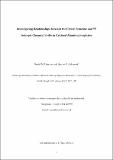Investigating Relationships between the Crystal Structure and 31P Isotropic Chemical Shifts in Calcined Aluminophosphates
Abstract
Solid-state NMR spectra have historically been assigned using simple relationships between NMR parameters, e.g., the isotropic chemical shift, and aspects of the local structure of the material in question, e.g., bond angles or lengths. Density functional theory (DFT) calculations have effectively superseded these relationships in many cases, owing to the accuracy of the NMR parameters typically able to be calculated. However, the computational time required for DFT calculations may still be prohibitive, particularly for very large systems, where structure-spectrum relationships must still be used to interpret the NMR spectra. Here we show that, for calcined aluminophosphates (AlPOs), structure-spectrum relationships relying on either the mean P-O-Al angle or the mean P-O distance, both suggested in previous literature, provide a poor prediction of the 31P isotropic shielding, σiso, calculated by DFT. However, a relationship dependent on both parameters yields predicted σiso in excellent agreement with DFT, with a mean error of ~1.6 ppm. The predictive ability of the relationship is not improved by introducing further parameters (many used in previous work) describing the local structure, suggesting that the two-parameter relationship is close to an optimum balance between accuracy and overparameterisation. The ability to predict accurately the outcome of DFT-level calculations will be of particular interest in cases where the actual calculations would be impractical or even impossible with current computational hardware, or where many such calculations are required quickly.
Citation
Dawson , D M & Ashbrook , S E 2014 , ' Investigating Relationships between the Crystal Structure and 31 P Isotropic Chemical Shifts in Calcined Aluminophosphates ' , Journal of Physical Chemistry C , vol. 118 , no. 40 , pp. 23285-23296 . https://doi.org/10.1021/jp507644z
Publication
Journal of Physical Chemistry C
Status
Peer reviewed
ISSN
1932-7447Type
Journal article
Collections
Items in the St Andrews Research Repository are protected by copyright, with all rights reserved, unless otherwise indicated.

